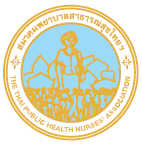The Development of the Nursing–based Continuing Care Guideline for Stroke Survivors with the Participation of the Hua Hin Hospital Health Network
Keywords:
Stroke patient care, Continuous nursing care, Participatory processAbstract
This participatory action research aimed to assess stroke patient care and develop continuous nursing care guidelines for Hua Hin Hospital and its network. The research comprised three phases: 1) planning for change, involving studying the problems and barriers in providing continuous nursing care, assessing the knowledge of the general public and at-risk groups, conducting post-stroke patient interviews, and collaborating with researchers to develop care guidelines;2) implementing and observing the guidelines, assessing collaboration, clinical outcomes, and conducting home visits; and 3) reflecting and providing feedback by analyzing data from interviews, group discussions, assessments, and records. Qualitative data underwent content analysis, while quantitative data were analyzed using descriptive statistics.
Findings revealed areas for improvement in stroke patient care, including 1) inadequate knowledge and skills in assessing symptoms and timely transfers, 2) limited experience in emergency patient transfers for stroke, 3) low awareness and understanding of stroke severity, and 4) inadequate integrated health services. Accordingly, the study proposes an action plan: 1) establishing a Community Stroke Team, 2) implementing the "Know Fast, Act Safe, Reduce Disability" campaign, and 3) providing continuous nursing care through Smart Discharge Planning, Smart Home Visit, and Smart Counselling. Process outcomes indicated participants' ability to assess symptoms, an average practice time of 196.25 minutes for patient transfers, and clear practice guidelines for healthcare providers and networks. Clinical outcomes showed emergency stroke patients received treatment within 210 minutes, and post-stroke patients receiving continuous nursing care had an 18.18% complication rate, effectively managed by the Community Stroke Team without rehospitalization.
Reflections on the study highlighted that the developed guidelines facilitated role alignment and raised community awareness and self-care abilities. However, enhancing problem-solving skills within the Community Stroke Team is necessary. This participatory action research provided comprehensive insights into stroke patient care and practical recommendations for improving continuous nursing care. The collaborative research process ensured its relevance and applicability within the context of Hua Hin Hospital and its network.
References
World Stroke Organization: (WSO). Up again after stroke. [Internet]. 2022 [cited 2022 October 30]. Available from: http://www.worldstrokecampaign.org/.
Tiamkao S. Recurrent ischemic stroke in Srinagarind Hospital. Journal of Neurology, Eastern Region 2011; 6: 31-38. (in thai)
Ministry of Public Health Policy and Strategy Office, Ministry of Public Health. National 20-Year Health Strategy (Health Sector). [Internet]. (2016). [Accessed January 10, 2023]. Available from: http://www.oic.go.th/FILEWEB/CABINFOCENTER2/DRAWER023/GENERAL/DATA0000/00000077.PDF.
Hua Hin Hospital. Summary of the development of stroke care services in 2022. Nursing Department, Hua Hin Hospital; 2022. (in thai)
Suradej Duangtipasirkul, Porntip Vachirachattilak, Teera Sirisombat, and Thira Sirisamut. Report on the Study of Emergency Medical Service Situation and Quality Improvement in Emergency Stroke Care. Nonthaburi: Emergency Medicine Institute; 2022. (in thai)
Emergency Medicine College of Thailand. Guidelines for the Treatment and Administration of Thrombolytic Therapy for Acute Ischemic Stroke Outside of Hospitals and in Emergency Rooms, 2020. Bangkok: Phramongkutklao Hospital; 2020. (in thai)
Miller EJ, Rice AK, editors. Systems of organization: The control of task and sentient boundaries. Routledge; 2013.
Kemmis S, McTaggart R. Participatory Action Research. In: Denzin NK, Lincoln YS, editors. Handbook of Qualitative Research. London: SAGE Publications Ltd.; 2000.
p. 567-605.
Michie S, van Stralen MM, West R. The behavior change wheel: A new method for characterising and designing behavior change interventions. Implementation Science. 2011;6:42. doi:10.1186/1748-5908-6-42.
Soto-Cámara R, González-Bernal JJ, González-Santos J, Aguilar-Parra JM, Trigueros R, López-Liria R. Knowledge on signs and risk factors in stroke patients. J Clin Med. 2020 Aug 7;9(8):2557. doi:10.3390/jcm9082557. PMID: 32784554; PMCID: PMC7463706.
Bandura A. Self-efficacy: The exercise of control. New York: W.H. Freeman and Company; 1997.
Poopitukkul J, Jokkrajai P, Ruangkhruawong S. Recognition of stroke signs and symptoms among stroke victims and their families. Journal of Thai Interdisciplinary Research. 2018; 13(6): 38-43. (in thai)
Rogers RW. Cognitive and physiological processes in fear appeals and attitude change: A revised theory of protection motivation. In: Cacioppo J, Petty R, editors. Social Psychophysiology. New York: Guilford Press; 1983.
Aneksak W, Seubniam S, Ninwanapa S. Perceived stroke warning signs among hypertensive patients, Suddhavej Hospital, Maha Sarakham Province. Academic Journal of Community Public Health. 2019; 5(4): 27-37. (in thai)
The Healthcare Accreditation Institute (Public Organization). Public Health Center Standards, 2nd Edition 2565
Kultipat A, Tohthong W, Sukmueang J,The Development of Comprehensive Care Stroke Patients in Phetchabun Hospital Network 2017; Region 11 Medical Journal. 31;619 – 630 (in thai)
Schoenfelder, J., Zarrin, M., Griesbaum, R. et al. Stroke care networks and the impact on quality of care. Health Care Manag Sci 25, 24–41 (2022). https://doi.org/10.1007/s10729-021-09582-0
Downloads
Published
How to Cite
Issue
Section
License
Copyright (c) 2023 Thai Public Health Nurses Association

This work is licensed under a Creative Commons Attribution-NonCommercial-NoDerivatives 4.0 International License.
บทความที่ตีพิมพ์และแผนภูมิรูปภาพถือเป็นลิขสิทธิ์ของวารสารพยาบาลสาธารณสุข (Thai Public Health Nurses Association)







